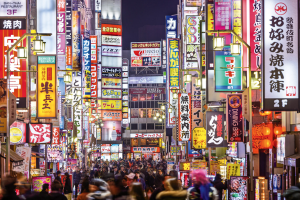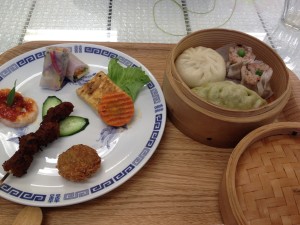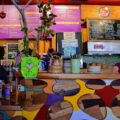 In what seemed like a fool hardy plan I booked a last minute trip to Tokyo with no prior experience of Japan and speaking no Japanese. As a long term strict vegan the prospect of spending two weeks in a country renown for their fish and inflexibility, rather than their vegan friendly cuisine, was a little daunting. I’m not the most adventurous of travellers, but I managed to eat, eat well and eat vegan. I thought my experience might help others, so here’s how I managed it and what I learned:
In what seemed like a fool hardy plan I booked a last minute trip to Tokyo with no prior experience of Japan and speaking no Japanese. As a long term strict vegan the prospect of spending two weeks in a country renown for their fish and inflexibility, rather than their vegan friendly cuisine, was a little daunting. I’m not the most adventurous of travellers, but I managed to eat, eat well and eat vegan. I thought my experience might help others, so here’s how I managed it and what I learned:
1) Online resources
Don’t be daunted; like this article, there is a wealth of online information already out there that can really help you. HappyCow is always my first stop, but many others including ‘Is it vegan Japan‘ and ‘Barnivore‘ for food and drink, as well as useful cultural information such as ‘Experience Japan with Yuka‘. In Tokyo there’s also free Wi-Fi offered for tourists.
2) Avoiding fish
Speaking to friends with Japanese contacts I found out that fish is in so much Japanese food and even the most basic miso soup or rice balls in omnivorous restaurants will likely contain bonito. Even if my Japanese language skills were up to conversing with the waitress, unlike America or the UK, Japanese chefs are reluctant to change or substitute ingredients because they want to make and present the food “as good as it could possibly be”, so to request a change is to undermine the effort they have gone to. However, fear not. Thanks to HappyCow I found that even somewhere as ‘fish-oriented’ as Tokyo there are a good number of vegan only and vegetarian only restaurants throughout the city. At these restaurants you can order anything on the menu and there’s no need to worry about any hidden fishy bits. If you are in mixed company it’s also worth checking out the reviews of some omnivorous restaurant too, as they can sometimes surprise you by offering ‘vegan specific’ menus, by initially sticking to vegan only places, I almost missed out on Chaya and The Pink Cow , both of which had excellent clearly-marked vegan food.
3) Food style
I like to eat at a range of restaurants, trying different styles and price ranges, especially on holiday. In Tokyo I tried a few very high-end, trendy restaurants, inexpensive noodle bars, cafés and tea rooms. While there was a good range of food I noticed there was a definite style to the vegan dishes on offer: grain salads are very popular (sticky rice, grains and vegetables in a light sauce), ramen (noodles, vegetables and tofu in a heavily flavoured broth) and vegetable soup (the style seemed to be a lightly season thin broth with large chunky vegetables). Two places that had really memorable food, and probably more of what I expected from Japan, were Loving Hut where we found vegan-ised steamed dumplings and Unadon (jellied eel on a bed of rice) and Komaki Syokudo which offered ‘shojin ryori’ or Buddhist temple food (many small courses of simple pickled vegetable, grains and flavoured beans, with a sesame ‘ice cream’ and red bean jam for pudding).
4) Language barrier
Even in central Tokyo English language skills vary substantially from person to person. In some places, the waiter will see you are a tourist and immediately offer you an English menu and start a conversation in English, other staff may only know a few words, and in some places no English is spoken at all. Don’t worry, there a few easy things you can do to get by:
- watch some online videos that tell you what to expect in Japanese restaurants. These will give you a really good feel for what to do, what not to do, and what order certain things will happen
- some basic body language and gestures go a long way i.e. hold up 2 fingers to indicate you want a table for 2 and if the waiter gestures widely with their arm then sit anywhere, if they lead you to a table, sit there
- many menus have pictures or some basic English titles ‘lunch’ ‘desert’, ‘soup’ or ‘set menu’ (usually a set menu offers a saving when 2 things are brought together – soup and salad)
- learn a few basic words, this small investment goes a really long way – ‘Sumimasen’ means ‘sorry’ but also functions as ‘excuse me’ to get the waiters attention, ‘kore kudasai’ literally means ‘this (kore) please (kudasai)’ and you can then point at what you want on the menu, ‘arigato’ thank you (you’ll use this a lot)
- when paying at the counter after my meal, I found staff often showed me the amount I owed on a calculator screen, which meant I could easily give the correct money.
5) Convenience stores
If you want to grab something for your room or a day trip then the convenience stores are a big help. There are 50,000 convenience stores across Japan, one on almost every corner. Lawson, Seven Eleven and Family Mart are the most popular and noticeably, the range of snacks available felt much more health-conscious than in the UK. My hotel provided breakfast but it wasn’t suitable (meat and boiled eggs) so every morning I went to the Family Mart and had a lovely roasted sweet potato (Yakiimo) (roasted in-store and available over winter). I would regularly pick up some Inari tofu and a plain rice ball for lunch. Naively perhaps, I wasn’t prepared for how little English there was on food labels, but again websites can help you with pictures of packaging and advice about what is vegan. The convenience stores also stock a big range of fresh vegetables and fruit if you want to make food in your room.
6) Finding your way around
As a vegan or vegetarian you’ll probably spend time looking for a specific restaurant so I’d strongly recommend getting familiar with the Japanese address system. Very, very few roads are named, rather most addresses consist of 3 numbers i.e. 55.20.6. Also note that businesses are not just on the ground floor (as space is at such a premium), so you might need to look up to find the café you were looking for.
Tokyo is a beautiful and bustling place to visit, and as a vegan, it’s easy to keep your stomach as full as your itinerary.
About the author: I’ve been vegan since 2002. I live in Southampton UK and love eating out, craft beer and travel. My twitter is @narniawithaT
Image source: Tokyo|InternationalTravellerMag







No Comments